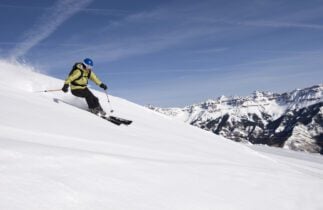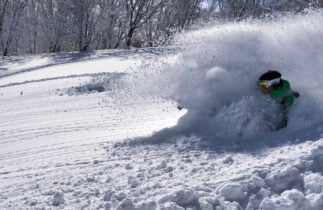The 4 Best Backcountry Skiing Areas in Jackson Hole
Table of Contents
Ask anyone who’s visited Jackson Hole and chances are they remember the moment they turned the corner on Highway 191 to catch their first glimpse of the striking silhouette of the Tetons.
Awestruck by the jagged scenery, it’s a common tale for skiers to decide on the spot to call it home.
We spoke with a few locals—who were charmed in just this way—about Jackson Hole’s backcountry skiing, and its reputation for being the steepest and most challenging in North America. Luckily, it turns out this western Wyoming ski hub has a variety of terrain suitable to skiers of all levels: massive couloirs, playful tree skiing, scenic ridgeline traverses, and easy backcountry access from resort boundaries make Jackson Hole a Magic Kingdom Dis-ski-land for adults.
If you find yourself inspired to go, good luck trying to leave.
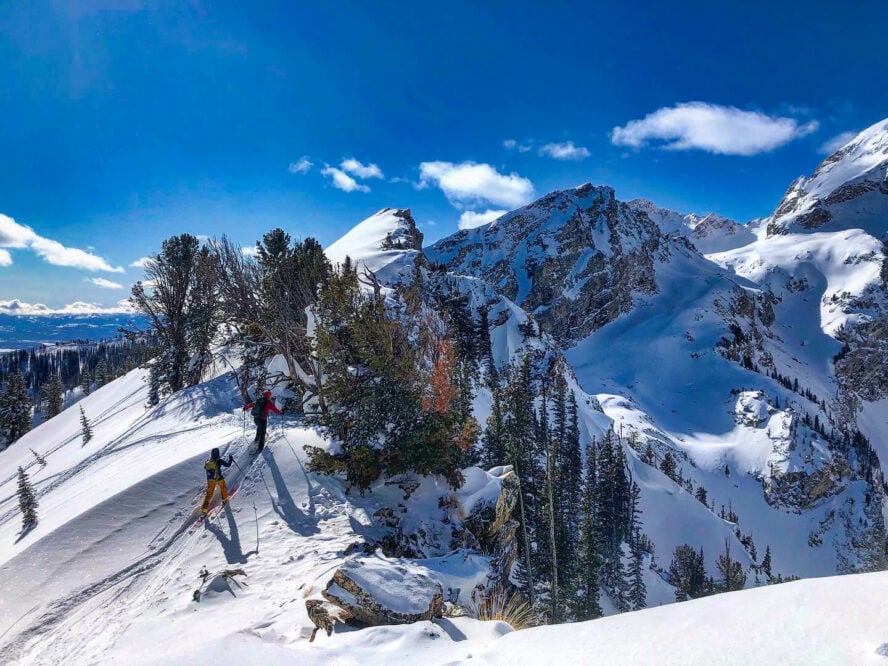
A quick Teton history lesson
Fur trading in the early 1800s is what originally brought European trappers to the Jackson Hole valley. In the 1820s, French trappers famously passed through Jackson and dubbed the three most prominent peaks Les Trois Tetons, or “The Three Breasts.”
The mountains caught the eyes of adventurers, and naturally, the roots of Jackson Hole backcountry skiing runs deep. In 1930, Fred Brown, just 16 years old, and Allen Hanks, the chief park ranger at the time, became the first ever to ski in Grand Teton National Park. Skiing in Jackson Hole soared post-World War II because of the 10th Mountain Division, as it did in many other (what are now) top destinations across North America.
In response to the growing interest in recreational skiing, the Jackson Hole Winter Sports Association was formed in 1945. By 1946 Wyoming’s first chairlift was installed at the local town hill. In 1965, Jackson Hole Mountain Resort (JHMR) opened its doors (and lifts) to the public.
Bill Brigg’s nail-biting first descent of the Grand Teton (13,776 ft) in 1971 marked a huge turning point for big mountain and backcountry skiing in North America. Even now that he’s past 90, you can still find him playing his banjo on Sunday nights at the Stagecoach Bar in Wilson for “Church,” attended religiously by locals for the last 50 years.
What was once a lawless cowboy operation became a world-famous destination offering some of the best skiing on Earth.
One Local’s Favorite Jackson Hole Backcountry Skiing areas:
Below, you’ll find four recommendations for the best places to ski (Teton Pass, Grand Teton National Park, Jackson Hole Resort Backcountry, and Grand Targhee) along with suggested spots and classic lines.
Map of Backcountry Skiing near Jackson Hole
Below, each marker indicates the skiing area.
So much extraordinary skiing to be had in one place—you won’t find this anywhere else.
1. Teton Pass

The backcountry skiing access on Teton Pass is as good as it gets. Drive over Teton Pass on any given day in the winter and the lot at the top will be packed with backcountry skiers gearing up for a ski tour. Heck, 6:30 a.m. during a weekday snowstorm can often be one of the busiest times, a testament to Jackson residents’ commitment to earning turns.
From the top of the pass, you have two options: Mount Glory and the powerline ridge
Strap your skis or board to your pack and head up the 1,600-foot Mount Glory bootpack (the north side of the road) or skin along the powerline ridge on the south side.
Booting up Glory is a quick way to get your heart rate up, and the best bang for your buck if you’re looking for some fast, rewarding turns before work. The south side offers a slower, more gentle pace to get started if you’re not in a hurry.
A mellow walk along the powerline ridge allows you to drop east or west into various tree runs and open bowls. Even a 15-minute walk can lead to a fun, playful tree run. Once you’re out there, you can link together short laps, climb back out, or ski out the closest drainage and end up a few miles down the highway. Hitchhiking is tolerated if not fully encouraged, and since every 3rd vehicle is a massive truck, it doesn’t take long to get picked up.
Avalanche danger
Be mindful that if you head up Mount Glory, especially after a storm, there are large slide paths that you have the potential to trigger. Glory Bowl and Twin Slides frequently bury the road, and it’s not uncommon to have morning traffic halted on storm days because of skier-triggered avalanches.

Join the community at Edelweiss
Located south of Teton Pass, Edelweiss is a small area famous for its bowl skiing. Its easy approach to high-grade powder makes it a great place for beginners to earn the first turns without much effort.
To reach the top of Edelweiss, start at the parking lot at the top of Teton Pass and gradually climb southwards over ridges and hills. When you reach the bowl, you’ll be treated to treeless skiing and spectacular views all around. Once you reach the bottom, it’s about a 900-foot skin back to the top.
Enjoy the intermediate playground of Mail Cabin Canyon
If you head to the west side of Teton Pass, you’ll find a host of exquisite bowls and slopes for intermediate backcountry skiers and the occasional open glade that will make any beginner giddy. Diversity is the name of the game here, and the numerous 500-foot laps are the icing on the cake. The best example is the Mail Cabin area.
Starting from the Coal Creek parking lot, cross the highway then skin up along Mail Cabin Creek. After around two miles, you’ll reach a fork which leads to East Mail Cabin Creek and West Mail Cabin Creek. On both sides you’ll find plenty of options for both short laps and all-day tours.
The east side holds runs such as the East Super Bowl, the moderately treed Moose Brush, and the lower and upper Columbia bowls.The west side is home to classic descents such as the Lone Pine Bowl, West Super Bowl and Windy Ridge.
Ditch the crowds on Mount Oliver
Another stellar area on the west side of Teton Pass is Mount Oliver, beloved for its mellow powder turns and expansive views—all without risk of running into crowds like the ones at Edelweiss.
Starting from the parking lot south of Highway 22, there’s a little over 2,000 feet to reach the summit above. From there you can enjoy some 500-foot laps on the northeastern face or hit the gentle north-facing slopes. On the northwest side you’ll find two equally exciting options that funnel into a gully which ultimately expands into a gorgeous flat meadow. This is where you’ll find the out track leading back to the parking lot.
Test your skills on Taylor Mountain
Taylor Mountain is located about two miles northwest of Teton Pass and can be reached either from Mount Glory or via the South Ridge, which provides an easier approach and descent. This is the go-to area for experts who seek out the adrenaline rush only a steep slope can provide.
Starting from the parking lot at Teton Pass, follow the north ridge to reach the summit of Taylor Mountain, where you’ll find two different descents. The first one will take you down the treeless East Face and into the valley below. This option will bring you a lot of vertical feet, but also high risk of avalanche. The second option goes down a stellar southeast-facing chute located close to the parking lot.
If you’re planning on backcountry skiing on Taylor Mountain, advanced avy skills, as you’ll learn in an AIARE Avalanche Level 2 Course in Jackson Hole, will go a long way to help prepare you for the unpredictable conditions that can arise in the wilderness.
Blessed with a deep, stable snowpack and a long touring season, Teton Pass is one of the most beloved ski touring destinations in North America.

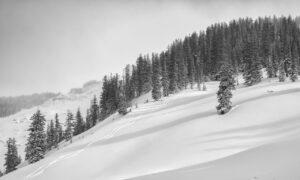
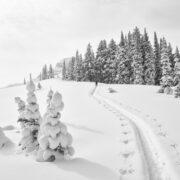
1. Teton Pass - Good to Know
Edelweiss: Beginner
Mail Cabin Canyon: Intermediate
Mount Glory: Intermediate
Mount Oliver: Intermediate
Taylor Mountain: Intermediate to advanced
Mellow powder slopes, steep bowls, open glades and everything in between.
10,352 feet (Taylor Mountain)
The parking lot at Teton Pass can be reached from Highway 22; the Coal Creek parking lot is located near the Coal Creek Trailhead off Highway 22.
High on the west side of Teton Pass.
The Stagecoach Bar. Down in the town of Wilson, the ‘Coach is the local watering hole for cowboys and sun-crusted ski bums alike. Take a seat at the bar, munch on some street tacos from the street food menu and soak up some serious country vibes. It’s a quintessential Wyoming experience.
2. Grand Teton National Park

Those willing to endure a long approach and some extra uphill will be rewarded with incredible scenery, long, sustained fall lines, and a fraction of the crowds that Teton Pass and the JHMR backcountry gates see.
Taggart Lake and Death Canyon are the two most popular winter trailheads to get into the heart of the park. Granite Canyon, closer to Teton Village, is less popular for backcountry skiers and provides opportunities to access some of the skiing on the south side of the park with a slightly longer approach.
No matter what, if you’re searching for wide open spaces that are increasingly hard to find in Colorado and Utah, ski mountaineering in Grand Teton is about as good as it gets.
Get the classic 25 Short experience
Considered a classic among backcountry skiers, 25 Short in Jackson Hole is one of Grand Teton National Park’s several must-ski locations. The name comes from its 9,975-foot peak, which leaves it just 25 feet short of being a 10er.
This ever-popular area boasts possibly the easiest access in the entire park, and moderate pitch beloved by backcountry skiers and splitboarders alike. Don’t get too relaxed, however, as you’ll still need good fitness and avalanche awareness to make it through safely.
From the Taggart Lake Trailhead you’ll start going uphill almost immediately. It will take you around two or three hours to reach the summit, and from there you’ll have your pick of excellent options. Whether it’s slaloming through dense trees, flying through open glades, or exploring nearby gullies, a 25 Short ski tour has it all.
This is a great place to go for first-time visitors because of the stunning views and possibilities for shorter or longer laps, depending on what the group is up for. Also, once you’re near the bottom, you can just follow the skin track on the northern approach to reach Mavericks.
Find easy access at Mavericks
Mavericks is a popular intermediate half-day ski tour that features big open meadows and several gullies that come in handy during avalanches. With relatively easy access, moderate pitch, and lots of great runs on offer, it’s no wonder backcountry skiers in Grand Teton National Park flock to it every year.
The mountain sits between 25 Short and Wimpy’s and is mostly mellow on the way up with the occasional steep section to spice things up. The first hour features only about 600 vertical feet before reaching the tail of the east-facing slide path on 25 Short. From there, you’ll climb up the southern side of the slide path, then follow the trees to the south until you reach the top.
Your reward will be some of the finest lines around—glade skiing and open powder sections all the way to the bottom. Altogether, the 3,500-foot ascent at Mavericks is a bit more technical (and shorter) than 25 Short, but no less brilliant.
Carve some couloir turns on Shadow Peak
Standing at 10,725 feet, Shadow Peak is situated north of Avalanche Canyon and southeast of Nez Perce Peak. This wild but enchanting mountain is famous for the Four-Hour Couloir, which splits the south face and runs for 2,000 feet at around 40 degrees, terminating in Avalanche Canyon.
From Taggart Lake Trail, enter the canyon east of the lake, then follow the Four-Hour Couloir along the east ridge to the summit. Once you get there, you’ll ski the same route back down. A steep treed section will siphon you into the couloir, where you’ll have plenty of wiggle room to carve wide arching turns.
It is recommended that you ski this route in early or late winter, while the roads are still open to traffic. Otherwise, you’ll probably need to hike a bit more to reach your starting point. And if you’re wondering where Avalanche Canyon got its name from, Shadow is known to offer big, rumbling reminders to skiers every once in a while.
Drop down from Wimpy’s Knob
If you’re in the mood for an excellent intermediate-level day tour, look no further than Wimpy’s Knob (or just Wimpy’s) on Albright Peak, approached via Death Canyon. It’s only a 3,000-meter skin to the top with some steep sections at the end, while on the way back you’re treated to a sustained descent through open powder slopes and gullies.
The terrain is slightly steeper and the trees more widely spaced than on 25 Short and Mavericks, but the crowds love them all just the same. Luckily, the eastern flank has enough terrain to accommodate a dozen groups at the same time, so you’ll always find fresh tracks.
If you’re looking to challenge yourself and step out of your comfort zone, the Park is the perfect proving ground for big ski mountaineering or peak bagging missions.



2. Grand Teton National Park - Good to Know
25 Short: Beginner
Maverick: Intermediate
Shadow Peak: Intermediate
Wimpy’s Knob: Intermediate
Best sustained fall lines in Jackson Hole.
10,557 feet (Albright Peak)
Low from March to mid-May, but come midwinter, few options remain safe from avalanches.
Dornan’s. On your way out of the park, be sure to stop here for a beer and a pizza. If the weather’s clear, you’ll enjoy an unobstructed view of your line through the floor-length windows behind the bar.
3. Jackson Hole Resort Backcountry

In the early days, freeride pioneers like Doug Coombs used to duck out of bounds from Jackson Hole Mountain Resort illegally to point their skis down some of the steepest terrain around. The easy access to the towering peaks just beyond resort boundaries was too tempting to resist. In 1999, the resort finally opened up access to the backcountry through seven designated gates (marked on the Jackson Hole Trail Map), allowing skiers and riders to exit the resort at their own risk.
Access the backcountry via the Aerial Tram
A ride up the 4,139-foot Aerial Tram lets you access some of the classics on Cody and No Name Peaks, with opportunities to ski wide open bowls and trees, or to scare yourself silly on near vertical faces, steep chutes and mandatory airs.
While the area can be intimidating, with plenty of opportunities to push your limits, some lines, like Four Shadows and Powder 8s, are far more mellow than they look from the resort.
Or bootpack
Granite Canyon, on the north side of the resort, can be accessed from the top of Après Vous or the top of the Headwall hike, a bootpack from the top of Cirque. Steep, sustained chutes let you ski perfect fall lines to the valley floor, with a traverse and long side step to get back into the resort.
Many of the backcountry ski lines from the resort don’t require the use of alpine touring gear since they involve a bootpack and usually drop you back into the resort without skinning. But don’t let this lull you into a false sense of security—underestimating the perils of the mountains can get you hurt.
Rock Springs
Due to its easy access, mostly mellow terrain, and proximity to the boundary line, Rock Springs Canyon is an inviting prospect for many skiers looking to acquaint themselves with the JHMR backcountry. But don’t think this will be a cakewalk. There are plenty of steep sections prone to avalanche and cliffs with blind takeoffs to keep you on your toes.
To reach Rock Springs Canyon, take the backcountry gate at the bottom of Rendezvous Bowl and head south through the trees. Once you reach a split at a large bench in the canyon, you’ll find the first entrance going down a large chute and into the skier’s left side of Rock Springs. Proceed along the bench to take the second entrance on the skier’s right side of the canyon.
The terrain inside is overflowing with benches and basins interspersed with short faces. Be careful not to get ahead of yourself, because there’s plenty of boulders, cliffs, and trees to spoil your backcountry bliss.
Jackson Hole Mountain Resort’s open backcountry gate system has access to more than 3,000 acres of beautiful backcountry terrain. What’s not to love?



3. Jackson Hole Resort Backcountry - Good to Know
In this vast backcountry, you’ll find plenty of lines for every skill level
Everything from mellow beginner slopes to extreme couloirs, chutes, cliffs, and gullies.
10,450 ft
Jackson Hole Mountain Resort is a short drive from the airports in Jackson Hole or Idaho Falls. You can park your car in the resort.
The area surrounding the resort is prone to avalanches.
TGR Continuum Hotel. Finish your day with a drink at the bar (or in the 30-foot hot tub) at the TGR Continuum Hotel. It’s a social atmosphere, packed with ski bums of all ages, with reasonably priced bar fare and TGR movies blasting on the screens at all times to get your stoke on for tomorrow
4. Grand Targhee

Located in Wyoming, but accessed from the Idaho side of Teton Pass, Grand Targhee Resort boasts a laid back mom-and-pop vibe—a stark contrast from the glitz and glamor of Teton Village. With all the hubbub swirling around Jackson Hole, “Ghee” often gets overlooked by visitors and locals alike, which makes the wait in line rarely longer than a minute or two
From Targhee, you can access some great intermediate backcountry terrain from the top of the Dreamcatcher or Sacajawea Lifts. Mary’s Nipple, accessed from the top of Dreamcatcher, starts with a short 650-foot bootpack with opportunities to ski back into the resort or down into Teton Canyon. Noodle Ridge is a fun, mellow tour, with options to ski multiple short laps before re-entering back into the resort.
Get your fill of powder in the Steve Baugh Bowl
Located just outside of the Grand Targhee Resort, east of Mary’s Nipple, is the Steve Baugh Bowl, an area popular among backcountry skiers hungry for sweet powder laps. If it’s skiing in the trees you’re after, you’ll find that on the bowl’s east ridge.
A lot of local skiers like to do the 2-3-hour tour to Little Mary’s, which might lack exciting descents, but still has plenty of charm to make up for it. You’ll also see folks going back into resort boundaries to drop down into Teton Canyon, but that should be done with caution as many lines there end in cliffs.
Go for loops in Teton Canyon
From Driggs, drive east on Ski Hill Road towards Grand Targhee Resort, then turn right onto Teton Canyon Road, where you’ll find the trailhead and parking area. From there, a ski trail heads south-east towards Teton Canyon, offering incredible views of the Grand, Middle and South Teton.
This 10-mile out-and-back trail offers excellent skiing on almost level terrain before culminating in a cul-de-sac at the parking lot and trailhead for the Alaska Basin. For variety’s sake, you can find some fun loops off the main road just a half-mile away.
If you wish to explore the upper valley, a tracked trail will take you from the end of the groomed past a waterfall and through a forested meadow. The route soon rises through a forest and goes into the back of the Canyon, bringing increased risk of avalanche.
Alternative Grand Targhee backcountry adventures
If you’re ever in the mood for ditching your skis and trying out something different, you have some cool options at your disposal. With 600 acres, 20,000 vertical feet, and exceptional views of the Grand Teton, a snowcat ride in Grand Targhee is one of the more exciting options. Another popular activity is heli-skiing, which allows you to access the remotest corners of the Teton backcountry.
With easy access to out-of-bounds terrain at Grand Targhee, you're guaranteed to get your fill of first-class freshies in the wild Wyoming backcountry.



4. Grand Targhee - Good to Know
Teton Canyon: Beginner
Steve Baugh Bowl: Intermediate
Diverse selection of mostly intermediate-level terrain.
7,851 feet
Grand Targhee Resort is a short drive from the airports in Jackson Hole or Idaho Falls. You can park your car in the resort.
The area surrounding the resort is prone to avalanches.
Trap Bar. You can’t visit Targhee without a plate of the Trap Bar’s famous Wydaho Nachos. Waffle fries replace tortilla chips, piled high with a generous helping of cheese, beans, guac, salsa… you name it.
Good-to-know Info for Visiting the Tetons
Transportation to and around the Tetons
Depending on where you’re traveling from, the Tetons make for a great long weekend or week-long trip in the winter. If you’re close enough, road tripping to Jackson is your best bet. Unless you’re traveling from town to Jackson Hole Mountain Resort, public transportation is limited so you’ll want to have a vehicle to get around.
Flights are limited and expensive to the Jackson Hole airport, but if you can score one that falls within your budget, it’s well worth it. The Jackson Hole airport is the only airport inside a national park—snag a window seat and scope your line from the plane before touchdown.
The best time to backcountry ski in the Tetons
Jackson Hole Mountain Resort is open from Thanksgiving through the second week of April and is typically crowded until closing day thanks to the resort’s 459 inches of average snowfall.
February and March are great months for Jackson Hole backcountry skiing, as coverage in the Tetons can still be a little spotty in January. March often has the most snowfall and less crowds, as long as you can dodge spring breakers.

Early season, Teton Pass is usually the first backcountry spot to be skiable thanks to the fact that you can park on top of the pass at 8,341 feet.
Skiing in Grand Teton National Park usually gets going mid-to-late January. If you’re looking to do some spring mountaineering, the national park is just about the best place in the world to be in April. A permit is not required to ski in the Tetons.
Why go backcountry skiing?
Although Jackson Hole is home to some of the world’s best ski areas, there’s a certain magic to skiing beyond resort boundaries that you can’t experience on groomed lines. Such a strong sense of exploration, freedom, and closeness to nature can only be found in the open wilderness, where skiers carve their own turns. If you’re looking to go on your first off-piste adventure, be sure to check out these useful tips for backcountry skiing.
Staying safe in the backcountry
There’s an inherent risk to venturing out into the mountains and facing unpredictable weather, terrain, or snowpack. It goes without saying that, to successfully navigate the backcountry, you should be an excellent skier who knows their equipment well.
However, the most important factor by far is avalanche safety. You should strongly consider taking at least an AIARE Avalanche Level 1 Course in Jackson Hole and enlisting the services of a licensed guide—even other pro guides do it!
Backcountry gear
For a regular day tour in the Jackson Hole backcountry, you should pack a 30-40-liter bag to carry all the necessary ski touring equipment. A shovel, avalanche probe and beacon (which you can learn to use on an Avalanche Rescue Course in Jackson Hole), skins, headlamp, snow saw, food and drinks—the list goes on. If you’re missing anything, you can buy or rent anything you need at a number of local gear shops.
Jackson Hole Backcountry Guides
Since 1968, Jackson Hole Mountain Guides have been taking skiers out to the Teton backcountry and ensuring their safety on the slopes. Accredited by the American Mountain Guides Association (AMGA), they organize everything from avalanche rescue courses and clinics to multi-day mountaineering journeys in and around Jackson Hole. They are dedicated to sharing their knowledge, experience, and love of adventure with the community.
Weather and Avalanche Forecasts
For up to date information on conditions, check out the Bridger-Teton Avalanche Center and Jackson Hole Mountain Resort Weather/Snow Report.
Optional (but encouraged) reading: Jackson Hole backcountry guide books
-
- Teton Pass Backcountry Guide (2016), a detailed guide for skiing on the Pass with images and detailed information on trailhead, mileage, and elevation.
- Jackson Hole Ski Atlas (2010), is a photo collection of the popular ski areas in the Jackson Hole area. It’s a useful tool to get oriented for the first time and a helpful reference to keep on hand while planning tours.
- The Black Book (2009), by Conor Miller, features aerial shots of ski lines from Grand Teton National Park. No beta or labels are provided, just drool-worthy shots of ski lines that aren’t always easy to spot from the road.

“I’m goin’ to Jackson, and that’s a fact.”
This was just a snippet of what Jackson Hole backcountry skiing has to offer, but we hope we’ve managed to get you stoked for some of the finest out-of-bounds terrain in the country.
The sport has grown exponentially since the resort opened its backcountry gates over 20 years ago—and shows no signs of slowing down. So if you haven’t tried going off-piste yet, the best time is now. And the best place is right here.


